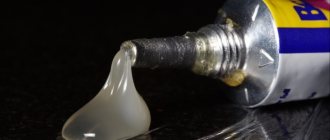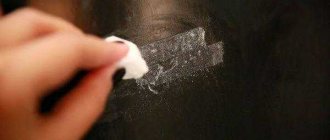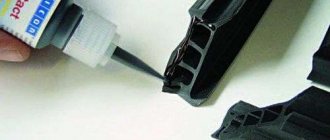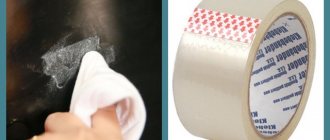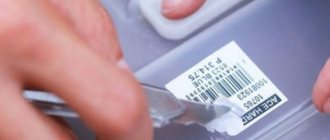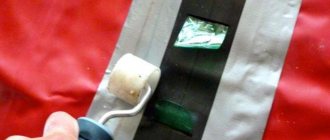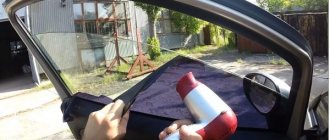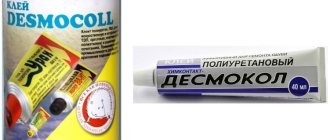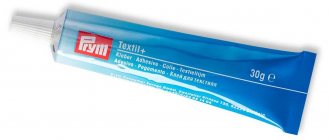Not all types of adhesives are suitable for repair, restoration and installation of plastic elements. Plastic polymers can melt, change their structure, color, or crumble under the influence of chemical compounds. In order not to damage the base and ensure a high level of fixation, you need to choose the right composition for each type of material.
Types of glue for plastic
Depending on the consistency, composition and principle of action on the surfaces being treated, the following types of compositions are distinguished:
- Liquid products are made based on water or synthetic solvents. They have the most fluid consistency and low level of adhesion. Forms an adhesive seam after the moisture contained in its composition evaporates. Therefore, until complete adhesion is achieved, it is necessary to maintain a period of at least a day. Suitable for joining the lightest, porous surfaces of a small area.
- Contact adhesives are produced in the form of two-component compositions (base and hardener). They form a rigid, inelastic bond that is susceptible to cracks under dynamic or vibration loads. They have a higher degree of fixation compared to liquid adhesives. They can be chemically active and cause poisoning, so personal protective equipment must be used when working with them.
- Reactive adhesives require exposure to certain factors for the polymerization reaction and bond activation. Some compositions are activated by ultraviolet radiation, moisture, lack of oxygen, or, conversely, under the influence of open air.
Form reliable and durable seams. They can glue plastic together tightly at home. Available in the form of one or two-component formulations.
- Hot-melt adhesive is available in the form of a core for special guns or thermal powder. As a result of heating, the composition melts and is applied to the surface of the elements being connected. Recommended for fixing parts of small volume and mass, mainly in applied arts.
Application by brush
Using any clean natural brush, apply dichloromethane until the layers are smooth. This solution is extremely volatile, so you won't have to wait long for it to dry. The obvious advantage of this method is that the solvent can be applied selectively, leaving sharp corners untouched, and the most noticeable print defects can be processed more thoroughly. The best processing results are achieved precisely in this way. Take precautions, breathing chemicals is not safe!
Glue for plastic: the best products
Today there are more than 300 brands of adhesive components for plastic surfaces. To choose the most suitable and high-quality adhesive for plastic, use the rating data presented below.
For better adhesion, before applying glue, thoroughly clean, dry and degrease the parts.
The best superglue
Superglue is a cyanoacrylate compound that bonds well to non-porous, glossy materials. Should set in less than a minute and reach maximum strength in 4-5 hours.
After using the glue, carefully remove any residue and ventilate the room.
- The first in the rating of superglues is Permatex Super Glue . The transparent, viscous composition forms a strong seam within 20 seconds. During tests under static loads, the strength of its joints exceeded those of other types of superglue. After curing, it does not crack or turn yellow in the sun. Produced in the USA in convenient packaging with a thin dispenser. This allows you to fix small parts and use the substance economically. Consumption 0.1 g. by 8 cm². Suitable for joining wood, porcelain, metal. Price for a tube is 2 g. from 130 rub.
- Glue Econ Express "Universal". Transparent, more liquid, has a pronounced chemical odor. Second in terms of seam strength. It stands out for its low price. Resistant to moisture. The glue is produced in China. The packaging is equipped with a thin dispenser cone and a cap that prevents the substance from leaking. Consumption 0.2 g. by 8 cm². setting speed 30 sec. Suitable for working with wood, rubber, ceramics. Packaging 3 g. costs from 30 rubles.
- Super glue "POWER". A transparent, thin adhesive component, third in terms of adhesive bond strength. A thin dispenser allows for precise application of the solution for economical consumption. After drying, it retains its transparency and does not crack. The glue is made in China. It does not have a strong odor. For 8 cm² 0.2 g is required. solution. Curing time – 20 seconds. Bonds wood, ceramics, tiles, rubber. Price per tube 3 g. from 55 rub.
Best waterproof
In addition to adhesion strength, this glue must be resistant to moisture.
- "Plastic Special" moment. Transparent, gel-like composition. Resistant to temperature changes and chemical reagents. May cause irritation and requires gloves to handle. Does not crack, does not change color. Produced in Russia using German technology. Substance consumption 3 g. by 5 cm². Curing time 3–5 minutes. Not suitable for fixing elements in contact with food. The adhesive is used to work with materials made of PVC, rubber, metal, rubber, tiles, and ceramics. Packaging price 30 g. from 45 rub.
- Waterproof plastic adhesive Loctite 406. The high price is due to the high level of adhesion. The liquid structure allows the substance to penetrate into small cracks. Curing occurs within 1–3 minutes. Has a strong, distinct chemical smell. Produced in Germany. Consumption 2 g. by 5 cm². Resistant to temperature changes from – 35 to + 90˚С. Not suitable for food grade plastics. Bonds PVC, glass, metal, wood, leather, cardboard. Packaging price 25 g. from 640 rub.
- Cosmofen Plus-S is an opaque, white composition. Widely used for installation and repair of plumbing communications, sealing seams. Resistant to UV rays and temperature changes. Can be used for outdoor work. Curing occurs within 3–5 minutes. 12 hours until completely dry. Produced in Germany. Has a strong chemical smell. You can work with it in a well-ventilated area. Consumption per 5 cm²–5 g. Suitable for sealing window and door openings. Packaging price 200 gr. from 250 rub.
Read also: Wood burner device
The best heat-resistant adhesive for plastic
Heat-resistant adhesives are used mainly for repair and maintenance of equipment components and assemblies.
- DONEDEAL heat resistant black. Universal thermal sealant for restoring plastic joints and gaskets of automotive system components. Forms a strong and elastic seam. Resistant to shock and vibration loads. Curing time 30 min. 24 hours until completely dry. Heat resistance: from -70°C to +345°C. Does not crack or crumble, is resistant to water and oil-based solvents. Made in the USA. Suitable for metal, glass, aluminum alloys. Package price 43 g. from 200 rub.
- Mastix Poxy Termo is a domestic two-component epoxy adhesive. It glues not only plastic parts, but also wood, ceramics, glass, and rubber. It sets within 15 minutes, maximum strength is achieved after 7–8 hours. Heat resistance from -50 to +250˚С. To work, you need to mix the base and hardener in a 1:1 ratio. Substance consumption per 5 cm²–8 g. When working with two-component materials, the mixed solution cannot be stored. May cause irritation if it comes into contact with exposed skin. The cost of packaging is 50 g. from 70 rub.
- Akfix HT300 is a Turkish, one-component adhesive with a high degree of adhesion. When forming a seam, it does not shrink or crack. Permissible operating temperature is from -40 to +250˚С. Forms an airtight bond within 24 hours. Sets in 7–13 minutes. Resistant to mechanical and vibration loads. Consumption 5 cm²–8 g. connects metal, plastic, rubber. Not recommended for elements made of natural stone or tiles, brass, glass, aluminum. The cost of packaging is 310 g. from 320 rub.
How to glue polypropylene with other materials
You have to be especially careful when choosing glue for gluing dissimilar materials. The selection process itself is simple: you need to carefully read the product description. It must indicate which substances can be used to glue PPR to: metal, wood, polyethylene parts, etc.
A universal option is a mechanical fastening. But in this case it is necessary to drill holes and use fasteners, which is not always acceptable.
The choice of glue is also influenced by the design features of the parts being fastened. For example, ceiling moldings, roofs, car panels, seals and gaskets, battery compartment parts, and dashboards require different adhesives because the seams experience different loads.
Metal and plastic are well joined by 3M Ultra-Clean Laminating Adhesive 502FL. The seam formed with its help can withstand ambient temperatures up to 350°C. Two-part products such as 3M Scotch-Weld and 3M VHB also work well.
As a universal solution, you can choose Dow Corning 7091, WEICON Easy-Mix PE-PP, Cosmoplast 500, Moment adhesive-sealant for polypropylene.
These products also cope with such a difficult task as the need to glue EPDM plastic.
Some tips for choosing
- Find out the type of plastic from which the elements are made in order to choose the right adhesive.
- Be sure to read the markings on the packaging with glue: PP glues polypropylene, PE-polyethylene, PS-polystyrene, PC-polycarbonate, PVC-PVC.
- Always check the quality of the packaging and expiration date. The tube must be hermetically sealed and have the manufacturer's instructions and instructions.
- To repair children's toys, choose a solution based on the composition of BF glue.
- Buy packaging in a volume that you can use as quickly as possible. Even tightly sealed compounds dry out over time and lose their adhesive properties.
- When purchasing an adhesive component, take into account the properties of additional materials if you are gluing dissimilar elements to plastic.
We recommend watching the overview video:
How else can you glue polypropylene
One of the very common methods by which polypropylene is bonded is hot welding. This method is often used in cases where it is necessary to glue polypropylene sheets.
It will not be possible to fasten sheet polymer material with an iron or soldering iron. You have to use either hot melt glue or a special welding method.
The most common methods include:
- diffuse welding - sheets are laid on a welding machine, fixed, and their edges are fused to the heating element;
- extruder welding - this machine can weld not only sheets, but also parts of arbitrary shape;
- with a construction hairdryer - you can make seams of any complexity, but the parts and the propylene wire that acts as glue must be made of materials belonging to the same class.
The most suitable welding method is determined by the size of the parts being joined, the complexity of the shape and the loads that the seam must withstand.
Instructions - glue the plastic together
Let's look at the procedure for performing the work using the example of one of the decorative plastic parts of a scooter (motor scooter), which is marked “ABS+PC”.
This symbol indicates that the part is made from a mixture of ABS plastic and polycarbonate. This combination is widely used for the manufacture of bumpers, all kinds of decorative trims and other parts.
You can glue a crack in this type of plastic using universal two-component epoxy glue EDP (Russia).
The glue itself is prepared by thoroughly mixing the resin and hardener in the ratio specified in the instructions. As a rule, take 1 part hardener for 10 parts of epoxy resin.
Work order:
- Preparation of bonded surfaces. Parts must be cleaned of dust, oil and other contaminants. Gluing is done from the inside so that the adhesive seam is invisible. For better adhesion, it is recommended to lightly treat the surface with fine sandpaper, degrease with a solvent (it is better to use ethyl alcohol), and dry;
- Fixation of parts to be glued. Unlike contact adhesives, which set instantly, epoxy resin cures within a few hours and does not require strong compression. It is enough to ensure the immobility of the two parts by grabbing them with clamps, clothespins or other available means.
- Application of epoxy composition. The joint is carefully coated with a thin layer of epoxy so that the glue is applied to each side of the crack. Then a layer of fiberglass is placed on the glue. Next, apply another layer of glue.
- Bonding time. The glued part is left to dry until completely set in a room with good ventilation. This takes 24 hours.
VIDEO INSTRUCTION
What else can you firmly glue plastic with?
Plastic is considered one of the most “capricious” materials in terms of gluing with other surfaces, but if you choose the right glue, then plastic can be firmly glued to metal, concrete, and wood.
It is recommended to use epoxy, polyurethane and phenolic rubber adhesives as glue for connecting polymer to metal. An excellent option would be cold welding Poxipol.
Using UHU Twist & Glue, most plastics can be bonded to wood, glass, ceramics and other materials.
Instant cyanoacrylate adhesives allow you to join plastic to metal, wood and rubber in seconds.
In everyday life, many have encountered such a problem as broken plastic products. These items can rarely be repaired with your own hands; it is safer to seal them. You can decide how to glue plastic tightly by considering the best adhesives for various types and gluing technology.
The easiest way is immersion processing
Very simple and fast processing, one printout takes no more than 3 minutes. We immersed Yoda in dichloromethane for 1-5 seconds, and over the next 1-2 minutes the solvent completely evaporated from the surface. To make a glossy surface, dip the part into the solvent for the last time for 0.5 seconds, it will not have time to be absorbed and will immediately evaporate, a candy-like gloss is guaranteed.
Very quickly, no need for a bath, no need for acetone. Dichloromethane is universal for PLA, ABS, HIPS, and possibly many other exotic materials. A liter lasts a long time. The tightness of the container for storing the solution is very important.
Determining the type of plastic
Before gluing plastic, it is important to first determine the type of material of the broken item. This is important to do in order to better glue the plastic and not spoil the product - many adhesives are solvents for plastic parts.
Most often, the manufacturer labels its products with a recycling symbol, which can be used to determine the type of plastic. It is a triangle with drawn arrows on the edges, inside there are numbers from 1 to 7.
Another indication of a brand is the letter symbols inside or next to the triangle. Knowing these designations, you can determine the type of plastic and then the appropriate plastic adhesive for it.
Marking
1 or PET is polyethylene terephthalate. The main area of application is food packaging. It is used in the production of artificial fibers, plastic packaging for liquid food products, and films.
2 or HDPE - high-density polyethylene using low-pressure technology. Used in the production of shrink film and packaging bags.
3 or PVC - polyvinyl chloride (PVC) is used in the manufacture of linoleum and plastic windows.
Read also: DIY solder for silver
Watch the video to find out more:
4 or LDPE - low-density polyethylene using high-pressure technology. Food grade plastic is used to make bags, wrappers and bottles, greenhouse film, packaging containers, toys for children, and pipes.
5 or PP - polypropylene, due to its inertness and heat resistance (it can be kept under hot steam and boiled), is widely used in the production of food packaging. The material is widely used in medicine (disposable syringes, catheters), in the production of household appliances, heat-resistant tableware and plastic pipes for hot water supply.
6 or PS - polystyrene. Disposable tableware (cups for food products) and the internal plastic lining of refrigeration devices are made from this type. By foaming polystyrene foam, a porous insulating material (foam plastic) is obtained, widely used in construction and manufacturing.
7 or O (Other) - materials that are not recyclable (combine a combination of foil, paper and polymer materials) or are not included in the previous groups.
One way to determine the brand of plastic in the absence of a sign is to test it by burning. Each material burns differently and with a different smell, from which you can determine its type.
What you need to know about gluing polypropylene
The question of how you can glue polypropylene with you is very important when it comes to repairing polypropylene pipes and other products made from PPR and PVC. This polymer material is difficult to glue, so special PP adhesive is required to obtain a reliable seam.
If the seam is subjected to dynamic loads, welding or soldering is often chosen. But a good waterproof adhesive for polypropylene pipes allows you to do without a soldering iron or heating, and if necessary, PPR can be glued to metal or other materials without soldering.
Marking of adhesives
In addition to plastic, glue for plastic is marked with symbols, although this designation rarely coincides with the recycling marking symbols. To know how to glue plastics together, the following letters are written on the adhesives to designate the materials being glued:
- polycarbonate - PC;
- acrylonitrile copolymer - ABS;
- polypropylene - PP;
- organic glass - PMMA;
- polyethylene - PE;
- polyvinyl chloride - PVC;
- polystyrene - PS;
- polyamide - RA 66;
- polyurethane - PUR.
Often it makes no sense to look for the markings on the glue packaging; it is enough to study the instructions in Russian, which clearly explain what types of materials the glue is intended for and how to glue the plastic.
Denture repair
A fracture of a denture can occur due to a fall of the structure, high load on it, loss of an abutment tooth, improper use or an error in the manufacturing process. Microcracks or chips prevent you from fully using artificial teeth, so you need to contact a dentist for repairs.
The product can be repaired in several cases:
- When breaking into several parts, a cut is made along the breaking line, after which the elements are cleaned with compressed air and filled with plastic.
- If a crack appears in the structure, it can be glued together and sealed using dental resin.
- The saddle-shaped part of the product is restored using wax - the material is applied along the fracture line.
- The plastic base is restored by laser welding.
- If an artificial tooth breaks off or falls out, the prosthesis is also subject to restoration (see also: what to do if an adult’s front or any other tooth falls out?). The dentist can reattach the broken unit or make a new one.
- Structures are subject to restoration if the clasp or fastening lock is broken.
READ ALSO: what to do if a front tooth breaks and its root remains in the gum?
Repair is carried out if there are no lost elements and the product is assembled into a single whole. If the arch, frame or stamped structure breaks, the prosthesis will have to be replaced (for more details, see the article: stamped crown: manufacturing stages and photo of the product). The process of restoring a plate prosthesis in the laboratory looks like this:
- parts of the product are held together using sticky wax;
- an insulating compound is applied to the structure from the side of the prosthetic bed to prevent adhesion of plastic and plaster;
- a fixing model is made from plaster;
- parts of the structure at the fracture sites are processed with cutters;
- plastic is mixed, after it swells, the composition is applied to broken surfaces;
- The prosthesis is placed in an apparatus for polymerization of the bonding paste, after which it is ground and polished.
Made of plastic
Plastic and acrylic dentures are used quite often, but unreliable base material leads to them breaking. However, do not be upset: cracks, broken bases, and lost units can be repaired by gluing, polishing and adjusting the product to the oral cavity.
READ ALSO: why could a crack appear in a tooth and what to do about it?
Self-hardening resins are used to glue the structure together. Polishing using a sealant makes the color transition invisible - so the patient will not feel psychological discomfort.
Made from nylon
It is quite difficult to break a nylon prosthesis - it is a flexible and durable product that can serve the patient for several years. Most often, there is a need to eliminate micro-scratches, reline, restore individual parts, or install new artificial units to replace lost ones.
Products are restored using special bonding liquids, then polished. If, after restoration of the nylon structure, the bite is disrupted or more serious damage occurs, the denture will have to be replaced.
Types of adhesives
There are many types of plastic products and they are widely used in everyday life, so gluing plastic can be done with a wide range of adhesives and different methods.
One of the gluing methods is to soften the surfaces of the parts to be glued with a suitable solvent (dichloroethane for plexiglass or polystyrene); after joining, the seam is securely soldered. In a similar way, you can make your own glue by dissolving small plastic shavings.
Liquid
Popular household adhesives are easy to use and come in two types: solvent-based or water-based. The principle of operation of the first is as follows: water or solvent evaporates from the glue applied to the top of the plastic parts, the adhesive seam dries with further hardening, due to this the parts hold tightly.
Such adhesives can glue plastic with porous materials that allow air to pass through, otherwise the water and solvent will not evaporate and the glue will not harden.
In everyday life and industry, good liquid PVA glue is known, widely used in furniture production for reliable gluing of artificial films on wooden surfaces; in the construction field, linoleum is often glued to PVA. Other liquid adhesives are made on the basis of rubber resins, in this case the solvents are methyl acetate, alcohol, and acetone.
Contact
The name was given because of the gluing principle: before gluing plastic to plastic, the surfaces of both glued products are coated with glue and after 10 - 15 minutes they are firmly pressed against each other. There are two types: with hardener and without hardener, the best known brands are BF-2(4), “Moment”, rubber glue.
In the video you will learn how to use contact adhesives:
Adhesives contain toxic materials, so at home, before gluing plastic, it is necessary to ensure the room is ventilated.
Reaction adhesives
There are one-component and two-component types. The former, when applied to the surface to be bonded, harden very quickly from interaction with oxygen or water vapor. These types include the well-known “Secunda”, “Superglue” and other analogues that can be sealed to form a rigid and durable seam.
Two-component ones have a hardener and a fixer that are located separately from each other. Before being used for gluing, they are combined and, after being applied to the surfaces to be bonded, under the influence of environmental conditions, they gradually begin to harden and glue the parts. They are based on various resins, the most famous types being polyurethane, epoxy, and polyester.
Hot melt adhesives
A separate type of adhesive that acquires its adhesive properties at high temperatures. To do this, the glue is placed in a special gun, where it is heated to 110 -120 C, then hot glue is applied to the plastic for gluing.
Watch the video to learn more about the gluing process:
Before tightly gluing plastic, it is necessary to establish its type using markings, comparing properties with descriptions, or physical experiments (combustion, solubility). Afterwards, it should not be difficult to purchase suitable glue for plastic and make reliable gluing with your own hands, following the instructions.
Addendum: Other Post-Processing Techniques
It should also be noted that PLA is easily sanded with regular sandpaper. In some cases, it is quite enough to get the surface as it should be, especially if you only need to remove traces of support or similar defects. Stripping is also very useful before chemical treatment. Just sand over problem areas and especially large artifacts, and then proceed as described above. This will save both time and reagent, and the finishing will be more accurate, without significant geometric distortions.
